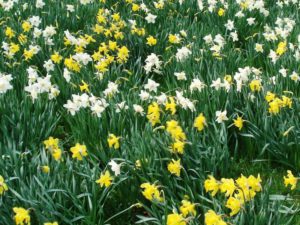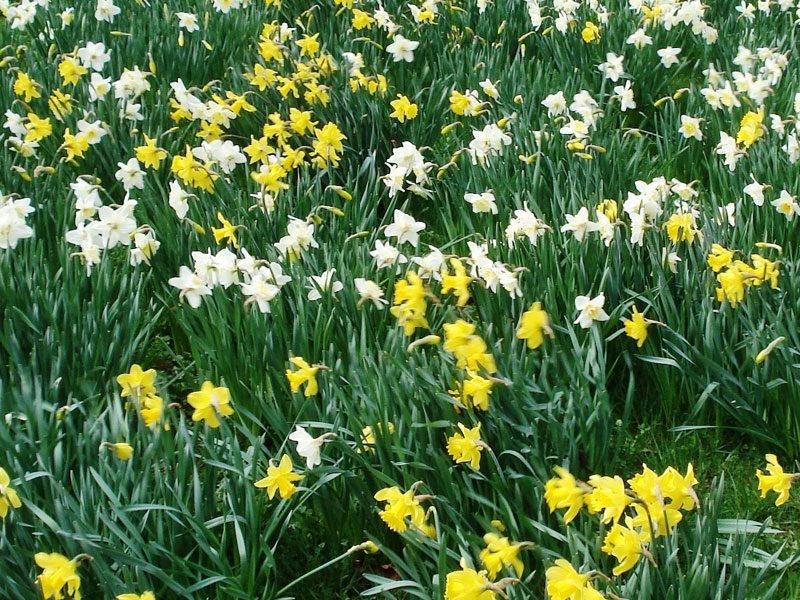There’s still no sign of the first green sprigs on the pecan trees here at the farm. Yes, I know we’ve had a gorgeous introduction to Spring, with our Kieffer pears blooming wildly, the camellias just about to finish their winter show, and the buds on the azaleas almost ready to burst. But I hold to the old-timers’ wisdom that there still could be a freeze until we see the emerging catkins on the pecans, so I’m not relaxing yet.
It has been a frustrating spring opening for me. Although I made it through a relatively mild case of COVID this past January (and have been subsequently vaccinated), I am still learning to cope with the debilitating post-recovery effects, which have made it impossible for me to work in the garden.

Narcissus
As a consequence, the various eruptions of springtime glory, both in the garden and in the woods, have been especially welcome.
Perhaps not surprisingly, it has been the wilder, less planned and less tended displays which have given me this joy. This year, the section of the front lawn here at the farm – covering a couple thousand square feet – that always pops up with hundreds of jonquils, daffodils, and narcissi, seemed to have three times as many blooms. The varieties are randomly placed, and they range from the sweet, multi-flowered tazettas, to white trumpet daffies and yellow King Alfred types, to the ancient contorted yellow-and-green-flowering “Van Sion.”
Years – no, many, many decades ago, when the yard of the farmhouse was bare dirt swept daily and surrounded by a low unpainted picket fence, the few, special ornamental flowers were planted at the base of trees around the homeplace. Assorted bulbs, perhaps shared by the farmer’s wife down the road, or maybe ordered from the farmer’s monthly newspaper with carefully saved nickels and dimes, were planted outside the fence in front of the house.
Those bulbs, left to naturalize, have managed to thrive even during our half-century of mowing the now five acres of lawn, and their grand display this spring has been especially rewarding.
Another of these massed spring beauties is the old-fashioned “cemetery iris,” Iris albicans, which has grown for centuries in its native Asia Minor, but which seems to find the Lowcountry climate perfectly suited to its thriving. There were several clumps around the property when we first arrived, blooming early but sparingly each spring. They had been neglected for decades, having to compete with cat briar and wild blackberries, so I brought in some additional bulbs I had removed from the site of my three-greats grandfather’s house at Erwinton. Cared for only marginally, they all grew, multiplied profusely, and bloomed.
About twenty years ago, a section that held a clump of these iris needed to be cleared, so they were roughly dug and moved to an ignored corner of a close-by field. There they were mowed down yearly, got no attention at all, and prospered. That field corner now is a swath of hundreds of iris plants all a-bloom in their white beauty with the faintest violet tint. Breathtaking!
In nearby Barnwell, there is a downtown lot, now empty except for weedy grass sometimes mowed, which suddenly each spring is covered in tiny star shaped flowers – white, with soft hints of blue or purple – appearing throughout the grass. Ipheon. Yet another of these glorious spring bloomers that love to naturalize in mass displays.
While I am handicapped in what I can do in the garden, it is these carefree awe-inspiring blooms which thrill me and invite my admiration. And, in these cases, it is the plants themselves which have decided where and how quickly to multiply and spread. None of these displays were made by buying bushels of bulbs and planting them in prepared soil. My kind of pandemic-gardening!
Gardener’s Hint: Here’s a radical way to get true bulbs to multiply quickly. You may want to practice first with a bulb you have plenty of, and it may make it easier with a larger bulb, like crinum or amaryllis. It’s called “twin-scaling.”
When the bulb’s leaves start turning brown and the year’s growth has filled the bulb with all the nutrients it will store for the next year, dig the bulb. Clean it well, trim off the top growth to the bulb’s tip and peel off any dried brown skin. Trim off the roots, but be careful not to disturb the “plate” – that rough-textured flattened area at the base of the bulb where the roots grow from.
Make sure the bulb is clean. Using a very sharp, very clean knife, cut the bulb vertically in half – from tip straight through the base plate. Now you can make additional vertical cuts through each half, cutting each half into two, three, or even four pieces. Each piece should have a portion of the base plate holding the section together; at the tip of each piece, trim back a tiny bit of the tip so that the “scales” or “leaves” of that section of the bulb can separate just barely at the tip.
You’ll have four, six, or eight bulb sections, each with some of the base plate attached. Dip each section in a fungicide, then allow to air dry.
Once they’re dried, some gardeners just plant the sections in small 4-inch pots filled with vermiculite or seed-starting medium. More cautious gardeners may prefer placing the sections together in a zip-lock plastic bag with moist, sterile vermiculite. Be sure to leave plenty of air space in the bag, and store in a warm dark space for three months. Watch for any fungal growth in the bag or on the bulbs.
When the sections grow miniature bulbs, bulbils, and tiny roots, they’re ready to be removed to 4-inch pots with sterile potting medium or to flats. Water them carefully.
Over the next year, they should develop roots and grow into little plants. It may take two years or more for them to get big enough to flower.
Photo credit: Genet at German Wikipedia








